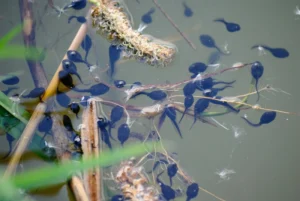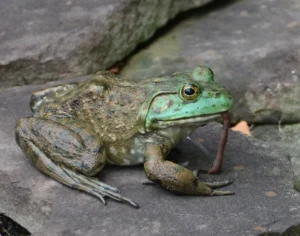Frogs are very opportunistic feeders and will eat almost any prey they can catch and fit into their mouths. Small frogs are mainly insectivores, but large frogs can also eat mice and even venomous snakes. But do frogs eat plants?
Frog tadpoles eat algae and the soft roots and leaves of aquatic plants. As they grow, the tadpoles will eat animal protein, in addition to plants. Once the tadpoles go through the process of metamorphosis and transform into frogs – they become obligate carnivores, and will not eat any plants.
Adult frogs are obligate carnivores, and their digestive systems are incapable of digesting plant matter.
Frog Tadpoles Eat Plants
Frogs start their lives as tiny embryos inside egg sacs. Their first food source for the developing embryos is the yolk of their eggs.
The yolk provides enough nutrition to sustain the developing tadpoles until they are ready to hatch into the water. This can take anywhere from a few days to as long as 6 weeks, depending on the species.
After hatching, the tadpoles will have poorly developed gills, mouths, and tails – so they can not properly swim or eat yet.
For this reason, they will spend the first few days feeding on the remaining yolk of the eggs. This will provide them with enough energy to grow and develop further.
After about a few days, the tadpoles would have developed enough to start free swimming and feeding on food sources available in the water.

At this early stage, tadpoles are almost completely herbivorous, and will eat:
- Algae
- Soft roots and leaves of aquatic plants (eg. duckweed mosses)
- Plankton
- Detritus (mostly composed of degraded plant materials)
Tadpoles have “beaks” and rows of denticles in their mouths, that help them to scrap off algae that grow on plants, rocks, or at the surface of the water.
In addition, they have very long tightly coiled intestines, that make up more than half of their body mass.
Plants contain cellulose, a compound that is very hard to digest. Because of this, plant matter needs to spend more time in the digestive system. This long intestinal tract gives tadpoles more time to break down the plant matter and absorb as many nutrients as possible.
As they grow their intestinal tract will gradually shorten, allowing the tadpoles to eat animal matter
In addition to plants, they will also eat:
- Aquatic insect larvae (glass worms, mosquito larvae, etc)
- Water striders
- Small insects that fall into the water
- Worms
- Carcasses in the water
Food Item |
Early Tadpole |
Late Tadpole |
| Algae | Yes | Yes |
| Plankton | Yes | Yes |
| Aquatic plants | Yes | Yes |
| Detritus | Yes | Yes |
| Ants | No | Yes |
| Small insects | No | Yes |
| Worms | No | Yes |
| Carcasses | No | Yes |
| Fish eggs | No | Yes |
| Fairy shrimp | No | Yes |
Whatever they eat, they will eat constantly. They have high energy demands because they are growing very rapidly. Growing big as fast as possible is necessary for survival, as they are an easy meal for most predators.
Tadpoles Turn Into Froglets
After a few months, to a few years (depending on the species), the tadpoles will go through a process known as metamorphosis, in which they will transform into juvenile frogs.

During metamorphosis, the thyroid gland secretes a growth hormone called thyroxine.
This hormone triggers the tadpoles to:
- Lose the gills, and develop lungs for breathing air
- Absorb the tail into the body
- Grow strong legs for moving on land
- Remodel other organs to form an adult frog
The tadpole’s beak is also shed, the denticles are reabsorbed, the mouth as a whole widens, and many frogs’ true teeth form.
In addition, the gut shortens dramatically, and the inner lining of the remaining intestine thickens, creating many folds in the process. These folds create a very large surface for the absorption of nutrients during digestion.
As the gut shrinks, a stomach is formed that secretes enzymes for digesting proteins.
Adult Frogs Do Not Eat Plants
Once the metamorphosis from tadpole to frog is complete – frogs become obligate carnivores, meaning they only eat animal matter and will not eat any plants.
They will eat :
- Snails, slugs
- Worms
- Milidpes, centipedes
- Beetles, flies, and a wide variety of other insects
Larger frog species also eat small fish, small birds, mice, and even snakes and other small reptiles.
They are opportunistic carnivores that will eat almost any prey they can catch, overpower, and fit into their mouths.

As earlier mentioned, frogs are instinctively attracted to movement while hunting for food. For this reason, most frogs will not eat dead bugs, or any other dead prey items.
In fact, many insects use playing dead as a way to avoid predators, including frogs. Some insects stop moving and stay perfectly still to prevent frogs from eating them.
Food Item |
Small Frogs |
Large Frogs |
| Ants | Yes | Yes |
| Insects | Yes | Yes |
| Worms | Yes | Yes |
| Snakes | No | Yes |
| Lizards | No | Yes |
| Mice | No | Yes |
| Birds | No | Yes |
| Vegetables | No | No |
| Fruits | No | No |
| Flowers | No | No |
| Leaves | No | No |
| Grass | No | No |
| Algae | No | No |
Adult Frogs Do Not Have a Digestive System Suited for Digesting Plant Matter
Adult frogs have short alimentary canals, suited for their strictly carnivorous diets.
Carnivorous animals like frogs generally have shorter digestive tracts than herbivores – because meat is dense in nutrients and they can extract these nutrients easier.
Their stomachs also make up a larger part of their digestive system than herbivores.
In addition, frogs have very powerful digestive enzymes, that help them to easily digest animal protein.
However, adult frogs may occasionally ingest plant matter when they eat hunt and eat prey – but they will never deliberately eat plants.
The Plant-Eating Frog
Although most frogs are obligate carnivores, there is one frog that is known to eat regularly eat plants: the Izecksohn’s Brazilian treefrog (Xenohyla truncata).
These frogs unique in that they are the only known frugivorous frog, out of more than 7,000 frog species in the world. They intentionally and often eats fruits, leaves, and flowers.
The amount of plant matter eaten by Izecksohn’s Brazilian tree frogs will depend on the blooming and fruiting seasons of the plants. When plants are unavailable, these frogs will eat various arthropods instead.
Since these frogs eat plants, in addition to animal matter, they are omnivores – rather than obligate carnivores.
Frogs Are Good for Your Garden
Frogs will not eat your garden plants but will eat grasshoppers, snails, slugs, and other pests that do.
Having frogs in your garden can reduce pest problems, without the need for pesticides.
In addition to eating pests, frogs are great bio-indicators that can tell you about the health of your garden ecosystem.
Frogs have thin, highly permeable skin and are very sensitive to pollution. Having frogs in your garden is a great sign that you have a clean, thriving, and healthy garden ecosystem.
They can’t live in polluted habitats and are sensitive to changes in their environment, so the presence of frogs or toads is a sign the habitat is healthy.
A sudden change in their presence can show that your garden has become polluted, or is unbalanced.
Commonly Asked Questions
Do Frogs Eat Vegetables? Frogs do not eat vegetables. In general, they are obligate carnivores and will only eat animal matter to obtain the nutrients they need. However, frog tadpoles are mostly herbivorous, and do eat vegetables, such as spinach, broccoli, lettuce, and Zucchini.
Do Frogs Eat Fruit? Frogs are generally obligate carnivores and do not eat fruit or any other plants. Izecksohn’s Brazilian treefrog are known to regularly eat fruits, leaves, and flowers.
Do Frogs Eat Grass? Frogs do not eat grass. They are obligate carnivores, which means they only eat animal matter. Frogs have short alimentary canals, suited for their strictly carnivorous diets – and can not digest grass, or other plants.
Do Frogs Eat Garden Plants? Frogs do not eat garden plants. They are obligate carnivores, and their digestive systems are suited for digesting animal protein, rather than plants matter. Frogs are good for your garden because they eat snails, slugs, grasshoppers, and other pests that eat your garden plants.
Conclusion
Frogs are opportunistic feeders that will make the best use of the food sources available in their environment. However, they are carnivorous, and will generally not eat plants.
Smaller frogs will mostly feed on ants, beetles, flies, and other small animals such as baby slugs and snails.
On the other hand, large frog species such as the American bullfrog will also eat small birds, snakes, mice, and other small mammals.
They are not very picky, so almost any prey they can catch, and swallow whole – is on the menu.
Photo credit: 哈布萊克 (CC BY-NC-ND 2.0)
Sources:
Altig, Ronald & Whiles, Matt & TAYLOR, CINDY. (2007). What tadpoles really eat? Assessing the trophic status of an understudied and imperilled group of consumers in freshwater habitats. Freshwater Biology. 52. 386 – 395. 10.1111/j.1365-2427.2006.01694.x.
Wassersug R. How does a tadpole know when to metamorphose? A theory linking environmental and hormonal cues. J Theor Biol. 1986 Jan 21;118(2):171-81. doi: 10.1016/s0022-5193(86)80132-1. PMID: 3458974.
Schreiber, Alexander & Cai, Liquan & Brown, Donald. (2005). Remodeling of the intestine during metamorphosis of Xenopus laevis. Proceedings of the National Academy of Sciences of the United States of America. 102. 3720-5. 10.1073/pnas.0409868102.
Zhang M, Chen H, Liu L, Xu L, Wang X, Chang L, Chang Q, Lu G, Jiang J, Zhu L. The Changes in the Frog Gut Microbiome and Its Putative Oxygen-Related Phenotypes Accompanying the Development of Gastrointestinal Complexity and Dietary Shift. Front Microbiol. 2020 Mar 3;11:162. doi: 10.3389/fmicb.2020.00162. PMID: 32194513; PMCID: PMC7062639.
Da Silva, Helio & Britto-Pereira, Monica & Caramaschi, Ulisses. (1989). Frugivory and Seed Dispersal by Hyla truncata, a Neotropical Treefrog. Copeia. 1989. 781–783. 10.2307/1445517.


